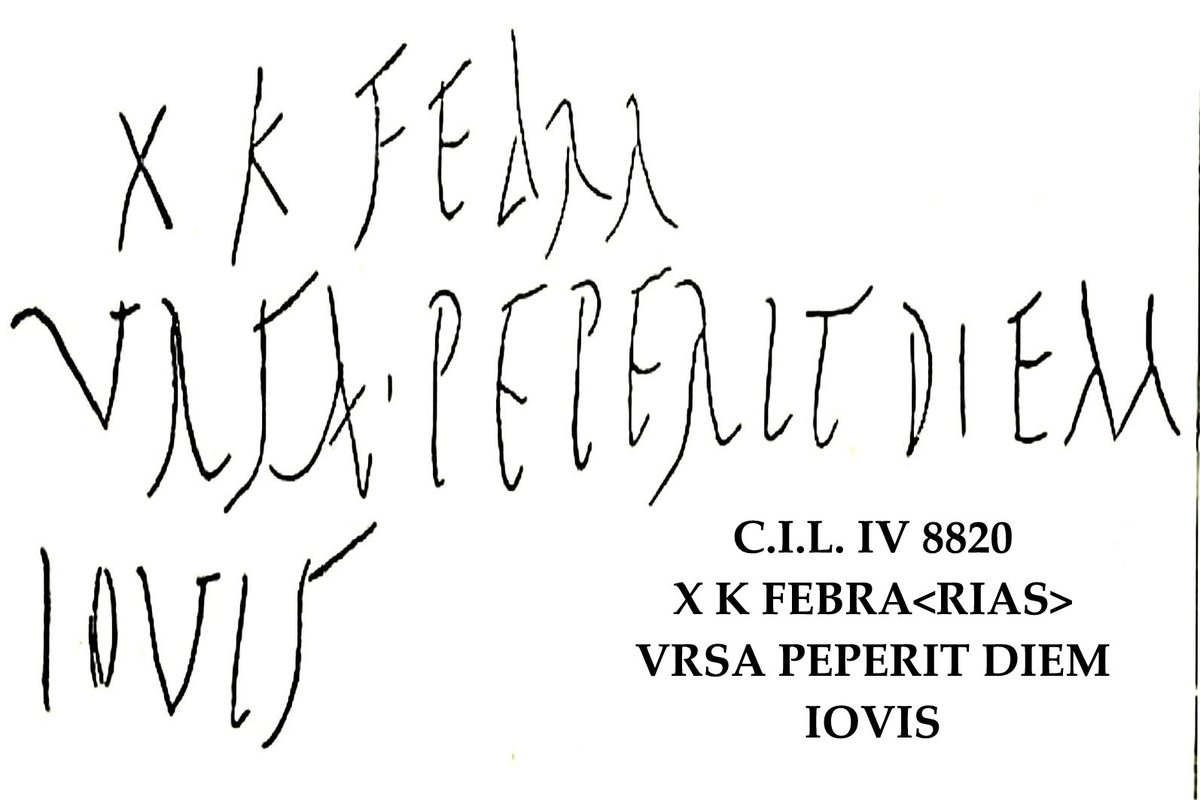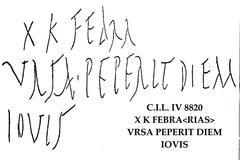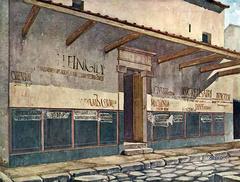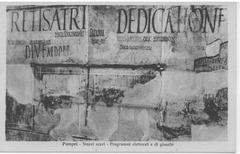
Visiting the House of Trebius Valens in Pompeii, Italy
Date: 14/06/2025
Introduction
The House of Trebius Valens stands among the most evocative and well-preserved Roman residences in Pompeii. This elegant domus, located along the bustling Via dell’Abbondanza in Regio III, Insula 2, offers visitors a rare glimpse into the domestic, social, and artistic life of a middle-class Roman family in the 1st century CE. Notable for its sophisticated architecture, vibrant frescoes, and significant epigraphic evidence, the house encapsulates both the private and public facets of Pompeian daily life. This guide will walk you through its historical background, key architectural and artistic features, and provide all the practical information needed for your visit (Pompeii in Pictures; ArchWeb; Pompeii Sites).
Table of Contents
- Historical Background and Owner Identification
- Architectural Features and Layout
- Decorative Elements and Art
- Epigraphy and Civic Life
- Archaeological Discoveries and Conservation
- Planning Your Visit: Hours, Tickets, Accessibility
- Visitor Experience and Practical Tips
- Frequently Asked Questions (FAQ)
- Visual Gallery
- Conclusion
- Related Articles and Further Resources
Historical Background and Owner Identification
Excavated between 1913 and 1915, the House of Trebius Valens (Casa di Aulus Trebius Valens, III.2.1) provides a prime example of a Roman middle-class domus from the city’s final years before the eruption of Mount Vesuvius in AD 79. The identity of its owner, Aulus Trebius Valens, is confirmed by multiple electoral inscriptions (programmata) and graffiti on both sides of the entrance, indicating his active participation in Pompeii’s civic affairs. These inscriptions also hint at interactions with neighboring households, reflecting the interconnected nature of Pompeian society (Pompeii in Pictures).
Architectural Features and Layout
Entrance and Vestibulum
Visitors enter through a modest vestibulum (entrance hall), typical of Pompeian homes, transitioning from the busy Via dell’Abbondanza into the private realm. The entrance, once fitted with a wooden door, features a rare bronze cylindrical doorbell—evidence of advanced domestic technology (Pompeii in Pictures).
Atrium and Social Spaces
Immediately beyond lies the atrium, the central reception area and social heart of the house. This space is defined by a sloping roof (compluvium) that channels rainwater into a central basin (impluvium), combining utility with aesthetic appeal. Surrounding the atrium are cubicula (bedrooms) and the tablinum (reception room), reflecting the classic domus layout (ArchWeb).
Peristyle Garden
The peristyle garden, surrounded by columns, forms the core of leisure and family life. Adorned with fountains, mosaic floors, and lush plantings, the peristyle exemplifies the Roman ideal of blending indoor and outdoor spaces. The columns and marble bases, some inscribed, may have supported honorary statues, further emphasizing the owner’s social status (pompeiiinpictures.uk).
Domestic and Service Rooms
Arranged around the atrium and peristyle are various rooms:
- Cubicula: Private bedrooms facing inward for security and privacy.
- Tablinum: The formal office and reception area, strategically located between atrium and peristyle.
- Triclinium: The dining room, lavishly frescoed and designed for entertaining guests.
- Culina: The kitchen, positioned away from main social areas.
- Aediculum: The household shrine for private worship.
- Service and Storage Rooms: Including spaces for servants and storage, reflecting the complexity of Roman domestic arrangements (ArchWeb).
Decorative Elements and Art
The House of Trebius Valens is distinguished by its vivid Fourth Style frescoes, especially in the tablinum and triclinium. These paintings depict mythological and Dionysiac themes:
- Seated Youth and Panther: Likely representing Dionysus, offering wine to a panther.
- Silenus and Flying Figures: Suggesting theatrical or mythological narratives.
- Theatrical Masks and Architectural Illusions: Common motifs that reflect contemporary artistic trends.
Floor mosaics in geometric and figurative designs, along with decorative elements like fountains and the aediculum, underscore the household’s taste and status (Getty Museum; ArchWeb).
Epigraphy and Civic Life
Electoral graffiti (programmata) on the façade provide invaluable insight into the social and political life of Pompeii. These inscriptions advocate for local candidates and advertise gladiatorial games, illustrating the blending of public announcements with private space and revealing the civic engagement of the house’s inhabitants (Pompeii in Pictures).
Archaeological Discoveries and Conservation
The house has yielded numerous artifacts—pottery, bronze pans, and household tools—shedding light on daily routines. Damaged during WWII, especially at the entrance, the house has benefited from restoration efforts that have helped preserve its frescoes and graffiti. Modern conservation employs advanced technologies like 3D scanning and pigment analysis to safeguard its heritage for future generations (Getty Conservation Institute).
Planning Your Visit
Hours and Tickets
- Opening Hours: Generally, Pompeii is open Tuesday to Sunday, 9:00 AM–7:30 PM (last admission at 6:00 PM); closed Mondays. Seasonal changes may apply (Pompeii Sites).
- Tickets: Admission to the archaeological park includes the House of Trebius Valens when open. Standard adult tickets are approximately €16, with discounts for EU citizens aged 18–25 and free entry for children under 18. Advance online booking is highly recommended (helenonherholidays.com).
Accessibility
While Pompeii’s ancient streets and houses can pose challenges, there are accessible routes; however, the House of Trebius Valens retains original Roman flooring and steps. Visitors with mobility needs should inquire about the latest accessibility updates.
Guided Tours and Apps
Guided tours, audio guides, and digital apps such as Audiala are available for a richer, self-paced experience. Specialized tours may provide access to areas not always open to the public.
Travel Tips
- Wear comfortable shoes and bring sun protection.
- Early morning or late afternoon visits help avoid crowds and heat.
- Only small bags are permitted; restrooms and refreshments are located near main entrances.
- Respect the site by not touching frescoes or mosaics and observing photography restrictions (thecollector.com; untolditaly.com).
Visitor Experience
Highlights Not to Miss:
- Bronze Doorbell: An ancient feature showcasing technological advancement.
- Tablinum Frescoes: Stunning mythological scenes in the reception room.
- Peristyle Garden: Central to family social life and leisure.
- Aediculum: The household shrine, reflecting religious devotion.
- Graffiti and Inscriptions: A window into Pompeii’s civic and political landscape.
Duration: Allocate 30–45 minutes for a thorough visit. Combine with nearby sites like the Forum and Villa of the Mysteries for a full Pompeii experience.
Frequently Asked Questions (FAQ)
Q: Where is the House of Trebius Valens located?
A: Regio III, Insula 2, Doorway 1 (III.2.1), north side of Via dell’Abbondanza.
Q: Is there a separate entrance fee for the House of Trebius Valens?
A: No; access is included in the general Pompeii ticket.
Q: Are guided tours available?
A: Yes, through both official and third-party providers; audio guides and apps are also offered.
Q: Is the house accessible for visitors with disabilities?
A: Some areas may be difficult due to steps and uneven flooring; consult accessibility guides before your visit.
Q: What makes this house unique?
A: Its well-preserved frescoes, civic graffiti, and evidence of daily and political life distinguish it from other Pompeian domus.
Visual Gallery

The main doorway with graffiti naming the owner.

Mythological frescoes in the reception room.
Conclusion
The House of Trebius Valens is a compelling testament to Pompeii’s vibrant civic, social, and artistic life. Its architecture and decorations blend innovation, beauty, and function, while its graffiti and artifacts offer a direct connection to the people who once lived within its walls. With its rich history and immersive atmosphere, it is a must-see for visitors seeking to understand the daily life and civic spirit of ancient Pompeii. For an enriched experience, use digital tools like the Audiala app, explore related sites, and consult official resources for the latest visiting information.
Related Articles and Further Resources
For more information and updates, visit:
- Pompeii in Pictures
- ArchWeb
- Pompeii Sites
- helenonherholidays.com
- Getty Museum
- Getty Conservation Institute

































































